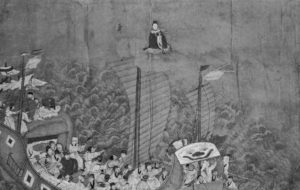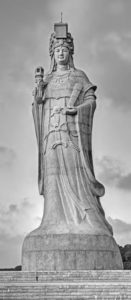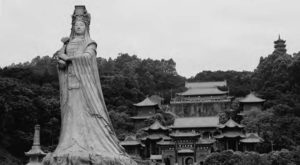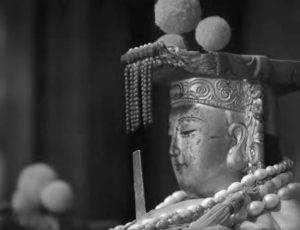
boat is also dressed in red and is shown kneeling in prayer. Ink on paper, c. 1700–1800. Source: Wikimedia Commons at https://tinyurl.com/sfk65kw.
The multiplicities of Chinese religion can be hard to grasp for North American students. For some, “Chinese religion” might bring to mind bustling temples with people offering incense to a dimly lit statue. When I teach Chinese religions, on the first day of class, I often ask students what they know about Chinese religions. There are always a few students who offer that there are three religions (Confucianism, Daoism, and Buddhism) in China, and sometimes a few will also offer that the People’s Republic of China officially recognizes five religions (Buddhism, Daoism, Islam, Catholicism, and Protestant Christianity).
The idea that China has three religions comes from the tradition of the sanjiao (three teachings) of Confucianism, Daoism, and Buddhism.1 Teaching about Confucianism, often through the Analects and Mencius, allows students to understand moral decision-making in the Chinese tradition, often centered on core values of humaneness (ren) and filial piety (xiao). The latter can lead to discussions of the family as the most important site for individual moral development, how the family is linked to the state and good governance, and the significance of ancestor veneration. Daoism, often taught through texts such as Laozi and Zhuangzi, presents a contrasting view, one that emphasizes naturalness, spontaneity, and the interconnectedness of the world. Laozi emerges as a figure that is venerated. The Daoist tradition also provides opportunities for students to understand bodily cultivation practices, from regulating the breath to imagining deities within the body to the preparation of talismans and elixirs. In the Shangqing revelations, immortals spoke to chosen beings, and what they imparted, which often took the form of poetry, was written. Exploration of these types of texts can provide insight into how deities communicated with the human realm and the different forms religious literature could take.2 Daoist rituals also exemplify the communication between human and divine realms, as they involve summoning the gods; contemporary documentaries, such as Han Xin’s Revenge, show this vividly.3 Buddhism, the third of the three teachings, is an Indian tradition that became Chinese (“sinified”) through the process of translation and adaptation to cultural and social norms. It offers a different cosmology—one centered on multiple universes and the paradises (Pure Lands) created through the vows of Buddhas. Buddhism also has a monastic tradition whose regulations shape alternate forms of religious life. The biographies of famed monks are individual examples of these lives in practice.

granite stones and are 47.5 feet tall. Source: ©123RF/Liu Chen-Chia.
Even this brief survey shows that learning about Chinese religions through the three teachings of Confucianism, Daoism, and Buddhism offers several different ways of thinking about religious life and practice. Yet an overemphasis on the three teachings can also leave students thinking that there are only three distinct faiths in premodern China and that being a follower of one of these traditions is like being a believer of Christianity in Europe or the United States. Treating Chinese religion through “-isms” flattens the diversity and richness of lived experience. Introducing Mazu addresses several key elements of Chinese religions: (1) how gods come to be; (2) how the worship of a god spreads; (3) how pilgrimages shape religious communities; and (4) the role of female deities. Mazu’s temples are often classified as Daoist, but this classification is not foregrounded in her story or devotional practices.
How Humans Become Gods
We might think of gods as beings that are above human beings and as unbounded by time—the gods were always there. This is not the case in China, where it was possible for humans to become immortal and to be treated as gods. Apotheosis, or deification, is one of the distinctive features of Chinese religious practice, but it can be a challenging concept for students coming from a monotheistic tradition. The story of Mazu and how she became a god provides an example of the process of deification. Tradition holds that Mazu began her journey to divine status as a young woman born in the tenth century to a family surnamed Lin that made their living through fishing. Later, she was called Moniang, or “Silent Maiden.” Stories about her childhood emphasize that she was, from an early age, an unusual girl—she is said to have refused marriage, for example. She was not unusual, however, in the practice of weaving, which was typical female work, and weaving plays a key role in Lin Moniang’s story. She fell into a trance at her loom and in the trance could see her father and brother at sea in danger. She was able to rescue her father, but her mother interrupted her trance and she dropped her brother. When her father returned, he verified what had happened, confirming Lin Moniang’s special powers. She died young, and shortly after death, she came to be worshipped as someone who could offer protection to those at sea.4
She might have remained a figure only of local importance to her home region in the coastal province of Fujian, but she continued to intervene in miraculous ways. In the twelfth century, Mazu is said to have saved an imperial envoy on a ship headed to Korea. Twelfth-century sources also note that merchants prayed to her before voyages. The association with merchants helped the worship of Mazu to spread, and by the thirteenth century, it had moved beyond Fujian; her continued efficacy in protecting those at sea proves the rationale for her continued and growing support.5
The imperial government not only gave titles to officials, but also to gods: the divine realm was organized into a bureaucracy that paralleled the one here on earth. This allowed the government to signal their support for gods that represented values they supported, and to integrate local gods and new traditions into a unified system. Going the other way, imperial recognition and promotion affirmed a god’s importance to the community of worshippers.6 Mazu’s growing popularity and importance were reflected in the titles she was given by the imperial government, first being named simply as “lady,” then elevated to “Celestial Consort”—which was later elaborated with descriptions—and finally “Empress of Heaven” (Tian hou).
The story of how Lin Moniang became Mazu is a clear example of apotheosis: when human beings exhibit divine powers, both before and after death, they can be elevated to divine status. This is a conception of deities and deification that is central to Chinese religion, and in contrast to how gods are understood in many other religious traditions.

How the Worship of Mazu Travels
As we have seen in the basic story of her life and elevation to divine status, Mazu is an example of a deity that began with a strong association to a particular place. The worship of her spread to neighboring regions through the nature of her miraculous intervention. Mazu’s close association with fishermen and other seafarers meant that her domain easily spread to encompass all those places that could be reached by boat from her home province of Fujian. Put another way, networks of fishermen, merchants, and others were also networks of religious practice, bringing Mazu to new places.
Taiwan was one of those places. The island was directly across the Taiwan Strait from Fujian, and the importance of fishing to both economies also facilitated the transmission of Mazu worship. Mazu became a very popular goddess on the island, gradually becoming tightly bound to Taiwanese identity. Ming loyalist and pirate Zheng Chenggong (also known by the honorific Guoxingye, romanized as Koxinga) said Mazu helped him defeat the Dutch in Taiwan in 1662. Two and a half centuries later, under Japanese occupation, worship of Mazu became a way of expressing Taiwanese religiosity in contrast to the Shintō and sectarian Buddhism of the Japanese colonial rulers. During World War II and the Allied bombing of Taipei, Mazu was said to have appeared in the sky to catch bombs in her apron. Her religious importance has not diminished, and her spring pilgrimage now is a major cultural and religious event in Taiwan.7
Worship of Mazu also spread to Southeast Asia, traveling with Chinese merchants and immigrants. Through these networks, temples to Mazu were established in Việt Nam, Malaysia, and the Philippines.8 Later, Chinese immigration to the United States brought the goddess across the Pacific Ocean. The first temple to Mazu (using, as many temples do, the title Tian Hou) opened in San Francisco in 1852. It has not been in continuous existence, and its ups and downs reflect, in part, restrictions on Chinese immigration. There is now a second temple to Mazu in San Francisco, with close ties to Taiwan, and one in Los Angeles with connections to Chinese–Vietnamese immigrants.9 Religious ties provide an alternative to state ways of defining communities and regions. The spread of Mazu temples shows how what might be called “Chinese religion” is found in other places and how American religious practice incorporates the traditions of immigrants.
Pilgrimages Are Multisensory Experiences That Shape Religious Communities
Mazu pilgrimages are important events each year in Taiwan that take place to coincide with the date celebrated as the goddess’s birthday, the twenty-third day of the third lunar month. During the pilgrimage, the statue of the goddess is taken out of the temple, placed carefully in a special sedan chair, and carried on foot for a tour of her territory. Pilgrimages may also reflect hierarchical temple relationships based on when temples were founded, through the networks described above. To establish a new temple, incense was brought over from an old temple, thereby creating a parent-child relationship between the two temples and their resident Mazus. The spring pilgrimage brings statues from a branch temple back to head temples in a form of homecoming.

Pilgrimages provide a way of introducing students to the ideas of liminality and communitas, both theorized by anthropologist Victor Turner.10 Liminality is a state of being in between, and for pilgrimages, this applies both to space and time. The time of the pilgrimage is set apart from regular time, both for the deity and the participants, who must deviate from their everyday routines for a period of time. As the statue of the deity travels, she also leaves behind her home space and moves between temples, lodged temporarily in the sedan chair used to carry her. Communitas, as Turner uses the term, refers to the temporary creation of intense communal bonds that differ from the social structures of everyday life. Although hierarchies continue to exist both among Mazu statues and among Mazu’s devotees—and local identities are particularly on display—the pilgrimage also brings people together in ways that dissolve or mute some aspects of social standing. This is seen, for example, in the way that pilgrims kneel on the road so that the sedan chair of the statue can pass over them. Communitas can also be seen in the groups or associations that form around the worship of Mazu and who participate in the pilgrimage together.
As should be clear, the treatment of the statues in the context of the pilgrimage also opens up conversations about what a statue is and how it relates to the deity. Statues are enlivened by the god’s presence through the placing of items within the statue (including incense from the main temple) and through ceremonies that, by dotting in the pupils, open its eyes. Statues are then ling (spiritually efficacious) and can respond to entreaties from worshippers. One of the ways that gods-in-statues communicate is through divination, which often takes the form of a petitioner asking a question of the god before the statue and then casting moon blocks, through which the deity communicates his or her answer. For Mazu, ling-ness is also connected to the temple’s place in the lineage, going back to the first temple to the goddess on Meizhou, a small island off the coast of Fujian. The spiritual efficacy of a temple is confirmed by miracles associated with the temple and by the number of worshippers who join the pilgrimage.11
The various elements of the pilgrimage provide a window into how rituals engage the senses. Chief among these is incense, the scent and smoke of which symbolizes the ling or presence of Mazu. On the pilgrimages, incense burns continuously and is part of the special sociality of the event: as the devotees who are walking with the goddess meet those who are unable to make the pilgrimage, they may exchange sticks of incense as a means of sharing the special powers of the goddess.12 Although incense may dominate, there are also other scents associated with pilgrimage, such as the smell of food and the smoke from firecrackers. The sounds of musical accompaniments, ritual performances, and the crowds of pilgrims are part of the experience, as are the intense visual displays—of the firecrackers, the performers, and the banners of religious associations accompanying Mazu. All of this adds up to an experience that is “hot and noisy” (renao), which anthropologist Adam Yuet Chau calls “the most desirable mode of sociality” for Chinese culture.13
The central role played by pilgrimages reflects the centrality of practice in Mazu worship and in mainstream Chinese religions as well. Those who are devoted to Mazu do not read a text about her; they do something—offer incense, carry the sedan chair, make food for pilgrims, form communities to worship her, and so forth.

Mazu’s close identification with Taiwan has meant that the goddess has, in recent decades, been put to political use in negotiating relations between Taiwan and the People’s Republic of China. Although Mazu is often taken as representing a Taiwanese identity, the goddess’s political role is more complicated than a single association: as historians of religion Vincent Goossaert and David A. Palmer put it, “Rather than a marker of ethnic or national divisions, then, Mazu appeared as a node linking and scrambling different polities and identities.”14 Mazu’s ancestral temple is located in Meizhou in the eastern part of Guangdong Province in the People’s Republic of China. The Mazu Temple in Beigang, Taiwan, received ash from the incense burners of the Meizhou temple in the Qing dynasty, which is one way the sacred efficacy of a temple is transmitted to a new site. Therefore, the Beigang temple is connected to Mazu’s home and so can serve as the “mother” temple for other Mazu temples in Taiwan. Although the incense at the Meizhou temple was extinguished during the Cultural Revolution (making the Beigang temple in some sense older), it remains a key site for pilgrimages. In fact, pilgrims from the Dajia Mazu temple visited Meizhou in 1987 and acquired an image there that allowed them to claim a direct link to the mother temple. The Meizhou Mazu visited Taiwan in 1997, an act that was seen as asserting a religious territorial claim with geopolitical implications. 15 Prior to 2008, pilgrims from Taiwan to the People’s Republic of China had to touch down in Hong Kong or Macau. Demands from Taiwanese Mazu pilgrims for a direct link to Meizhou had begun a decade earlier and were part of the 2000 presidential campaign. Media coverage of Mazu pilgrimages provided another way in which religious connections between the two countries were pursued.16 Mazu’s political importance resurfaced in Taiwan’s 2020 presidential elections, when the goddess was said to have advised Foxconn Chairman Terry Gou to enter the race (he dropped out a few months later).
Female Deities
Teaching about Mazu also provides a way to introduce the importance of female figures in Chinese religions. The three teachings center on men: Confucius, Mencius, Laozi, and the historical Buddha are all male. The monastic tradition of Buddhism has been dominated by men, and Daoist priests are also overwhelmingly male. Mazu’s story, on the other hand, shows the young Lin Moniang as both an ideal woman, engaged in the traditional female occupation of weaving, and compassionate toward those who need her aid. Her story also suggests ways that women might resist, as she never married.
Mazu might also be linked to other female deities, in particular the bodhisattva of compassion Guanyin, who come to be depicted as female in imperial China. Stories about Guanyin in her incarnation as Princess Miaoshan illuminate the tension between religious life and feminine ideals.17 Importantly, both Mazu and Guanyin remain exceptionally popular today.
Bringing Mazu Worship Alive—Sources for Teaching
The importance of Mazu pilgrimages, the spread of Mazu temples, and the centrality of the deity to Taiwanese identity mean that there are a number of multimedia resources available for teaching. As I have noted above, the textual tradition around Mazu is less important than the lived tradition of practice. Documentaries, shorter online videos, and websites provide insight into that tradition. The documentary Mazu Procession (Mazu nai, Taiwan with English subtitles) follows singer and actor Richie Jen as he participated in the pilgrimage in 2013. Although Jen’s celebrity can be distracting, the film provides a firsthand view of what it is like to walk with Mazu. Another documentary, Happy Birthday Mazu, follows the members of a San Francisco temple as they return to Taiwan with their Mazu statue. This film shows the transnational dimension of Mazu worship.
There is also a multitude of Mazu videos on YouTube, including one produced by UNESCO.18 Another short video discusses how Mazu’s story is interpreted in performance. Both the government of Taiwan and of the People’s Republic of China have posted videos on Mazu, and there are also many amateur videos made by tourists. Travel and news websites provide information on temples and the annual pilgrimage. For students interested in the intersection of religion and media, these online sources are a way to explore the different presentations of Mazu and the pilgrimage.
Children’s books provide another source for understanding Mazu, especially for students who are also studying the Chinese language. Both Welcoming Mazu (text by Cao Mingzong and illustrations by Liu Feng, Xinbei: Lianjing, 2019) and Mazu Goes Home (text by Zhang Lingling and illustrations by Wang Jiazhu, Taibei: Yuanliu, 2003) contain lavish illustrations to give a sense of the drama of the pilgrimage. The text explains both Mazu’s history and various elements of the pilgrimage. In Mazu’s Spring Lark (Mazu chun youqu), written and illustrated by Zhang Xiuyu, the young narrator experiences the pilgrimage seemingly for the first time. This is also available in PDF form from the Taizhong city government.19
With resources such as these, Mazu can be introduced through words, images, and sounds. The inclusion of this goddess and her pilgrimage in instruction on Chinese religions opens up a number of different avenues for discussion, from the theory of religion to contemporary politics.

